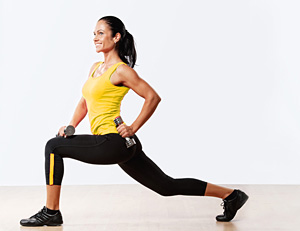Approach Resistance Training With Continual Change in Mind
By Corey Mote, BS, DC
Proper weight training is an important aspect of an overall comprehensive wellness strategy, but the wrong information can lead to poor results, burnout and ultimately, failure to adhere to this important aspect of an overall wellness regimen. The concept of periodization can help avoid these potential problems.
There are as many philosophies for varying your fitness routine with the intent of attaining overall optimal fitness as there are fitness trainers. Most trainers typically agree that sets should range anywhere from six to 15 repetitions per set, performing three to six sets per session. Some believe one must train with heavier weights, doing six to eight repetitions per set, in order to maximize strength for a given sport-specific action or movement; while others will shoot for 12-15 repetitions per set with lighter weight for strength endurance. For those looking to develop musculature while simultaneously shooting for optimal definition (as in physique sculpting), the majority probably agree that the midrange of eight to 12 repetitions is best.
So, which range of repetitions should you perform in order to optimize your performance in a given sport? Well, all three – regardless of the sport. If you train using the same method throughout the year, you are asking for musculoskeletal injuries, as well as psychological burnout. A plateau is quickly reached and may not be broken without some sort of modification in the regimen. You will not see improvement without periodic alteration in the way in which the musculature is trained.
Periodization Training
 An athlete's workout regimen is typically multifaceted, but should most notably be differentiated via the incorporation of periodization – a method of alternating training loads to produce peak performance for a specific competitive event. Periodization is a well-established scheme adopted from Russia, as it was one of the "secrets" that helped Russian athletes dominate Olympic sports for so long. But it's not just for Olympians; periodization can be incorporated into the training program of an athlete, amateur or professional, for virtually any sport.
An athlete's workout regimen is typically multifaceted, but should most notably be differentiated via the incorporation of periodization – a method of alternating training loads to produce peak performance for a specific competitive event. Periodization is a well-established scheme adopted from Russia, as it was one of the "secrets" that helped Russian athletes dominate Olympic sports for so long. But it's not just for Olympians; periodization can be incorporated into the training program of an athlete, amateur or professional, for virtually any sport.
Specifically, resistance-training periodization is a technique of varying the intensity level and volume of a weight-training program on a regular basis to not only increase the benefits gained, but also to reduce the risk of injury. Instead of maximizing the amount of weight you lift every time, you lift heavy weights with low repetitions for a period of time, then follow this with a period of using lighter weights and a higher number of repetitions.
Periodization programs are comprised of three distinct cycles. These cycles are known as macrocycles, mesocycles and microcycles. Think of a macrocycle as the entire program itself, which may envelop several months to a year of training (depending on one's goals and how the program is designed). One macrocycle consists of multiple mesocycles, which may range from several weeks to a few months each. Each mesocycle is divided into microcycles that generally range from one to four weeks. Microcycles include daily and weekly training variations.
Taking Advantage of Muscle Confusion
The idea of periodization training is to regularly change up your routine so your muscles are continually "confused." The result: the muscles will respond more to training, growing stronger and bigger rather than getting used to the "same old" workout routine.
So many people who hit the gym seeking to better their performance in their sport, or to just improve their physiques, make the mistake of working out exactly the same way week after week. They soon end up hitting a plateau after a few months and frustration sets in. The reason this happens is because the muscles are getting the same stimulus every week (same exercises, same number of reps, same number of sets, etc.). When you change up the elements in your routine, you keep your muscles guessing, and guessing usually means growth, strength improvement, and ultimately better performance.

